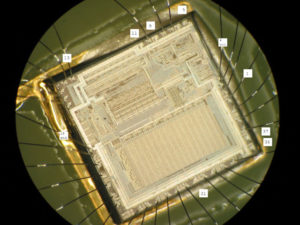 Recover Chip MC9S08DZ32ACLC Firmware
Recover Chip MC9S08DZ32ACLC Firmware
We can Recover Chip MC9S08DZ32ACLC Firmware, please view below the Chip MC9S08DZ32ACLC features for your reference:
8-Bit HCS08 Central Processor Unit (CPU)
· 40-MHz HCS08 CPU (20-MHz bus)
· HC08 instruction set with added BGND instruction
· Support for up to 32 interrupt/reset sources
On-Chip Memory
· Flash read/program/erase over full operating voltage and temperature
— MC9S08DZ60 = 60K
— MC9S08DZ48 = 48K
— MC9S08DZ32 = 32K
— MC9S08DZ16 = 16K
· Up to 2K EEPROM in-circuit programmable memory;
8-byte single-page or 4-byte dual-page erase sector;
Program and Erase while executing Flash; Erase abort
· Up to 4K random-access memory (RAM)
Power-Saving Modes
· Two very low power stop modes
· Reduced power wait mode
· Very low power real time interrupt for use in run, wait, and stop Clock Source Options
· Oscillator (XOSC) — Loop-control Pierce oscillator;
Crystal or ceramic resonator range of 31.25 kHz to 38.4 kHz or 1 MHz to 16 MHz
· Multi-purpose Clock Generator (MCG) — PLL and FLL modes (FLL capable of 1.5% deviation using internal temperature compensation); Internal reference clock with trim adjustment (trimmed at factory, with trim value stored in flash); External reference with oscillator/resonator options in the process of Copy microcontroller
System Protection
· Watchdog computer operating properly (COP) reset with option to run from backup dedicated 1-kHz internal clock source or bus clock
· Low-voltage detection with reset or interrupt; selectable trip points
· Illegal opcode detection with reset
· Illegal address detection with reset
· Flash block protect
· Loss-of-lock protection
Peripherals
· ADC — 24-channel, 12-bit resolution, 2.5 ìs conversion time, automatic compare function, temperature sensor, internal bandgap reference channel
· ACMPx — Two analog comparators with selectable interrupt on rising, falling, or either edge of comparator output; compare option to fixed internal bandgap reference voltage.
· MSCAN — CAN protocol – Version 2.0 A, B; standard and extended data frames; Support for remote frames; Five receive buffers with FIFO storage scheme; Flexible identifier acceptance filters programmable as: 2 x 32-bit, 4 x 16-bit, or 8 x 8-bit
· SCIx — Two SCIs supporting LIN 2.0 Protocol and SAE J2602 protocols; Full duplex non-return to zero (NRZ); Master extended break generation; Slave extended break detection; Wakeup on active edge.
· SPI — Full-duplex or single-wire bidirectional; Double-buffered transmit and receive; Master or Slave mode; MSB-first or LSB-first shifting
· IIC — Up to 100 kbps with maximum bus loading; Multi-master operation; Programmable slave address; General Call Address; Interrupt driven byte-by-byte data transfer
· TPMx — One 6-channel (TPM1) and one 2-channel (TPM2); Selectable input capture, output compare, or buffered edge-aligned PWM on each channel.
· RTC — (Real-time counter) 8-bit modulus counter with binary or decimal based prescaler; Real-time clock capabilities using external crystal and RTC for precise time base, time-of-day, calendar or task scheduling functions; Free running on-chip low power oscillator (1 kHz) for cyclic wake-up without external components Input/Output
· 53 general-purpose input/output (I/O) pins and 1 input-only pin
· 24 interrupt pins with selectable polarity on each pin.
· Hysteresis and configurable pull device on all input pins.
· Configurable slew rate and drive strength on all output pins.
Package Options
· 64-pin low-profile quad flat-pack (LQFP) — 10×10 mm
· 48-pin low-profile quad flat-pack (LQFP) — 7×7 mm
· 32-pin low-profile quad flat-pack (LQFP) — 7×7 mm
